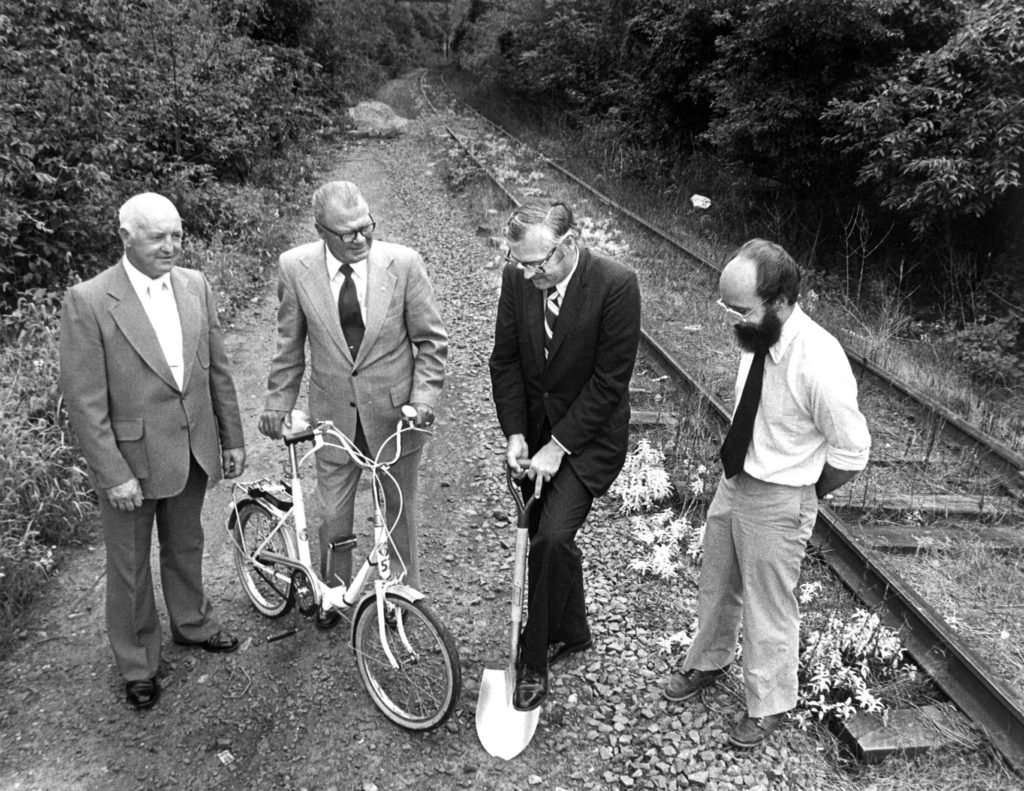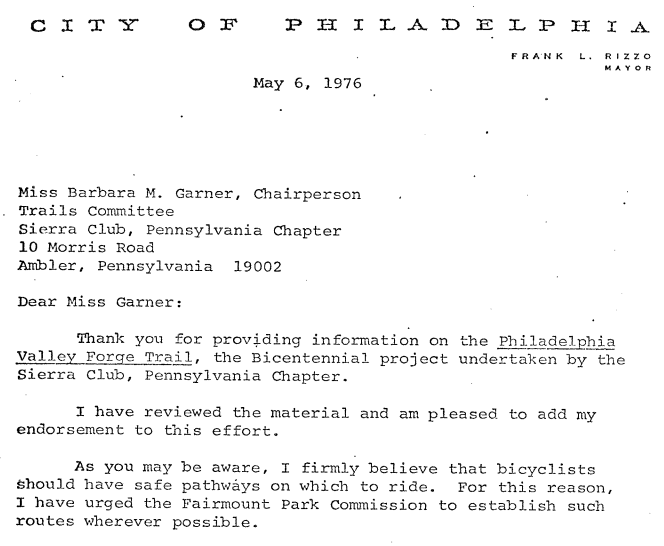
Bob McConnell, the Executive Director of the Fairmount Park Commission (left), two Mont. Commissioners, and Jim Campbell of the Sierra Club (right) at the groundbreaking of the Schuylkill River Trail, in 1979.
Written forty years ago, Philadelphia Mayor Frank Rizzo wrote a letter to the Sierra Club documenting his support of what is now the Schuylkill River Trail.
That letter, recently provided to the Bicycle Coalition of Greater Philadelphia by Mike Stokes of the Montgomery County Planning Commission, is an artifact of the effort that led to the creation of Southeastern Pennsylvania’s flagship bicycle route. It is available to read here. What follows is an abbreviated history of how the process began.
In the early 1970s, the local branch of the Sierra Club wanted to make a splash. The American Bicentennial was fast approaching, and nowhere was that anniversary more important than in Philadelphia, the City where independence was declared. The Sierra Club conceived of a project big enough and important enough to honor the occasion.

Screenshot from letter from Mayor Frank Rizzo to the Sierra Club
The group would propose a pedestrian, bicycle and equestrian trail running from Independence Hall to Valley Forge, where General George Washington’s Continental Army had spent a miserable winter from 1777-1778.
At the time, the Sierra Club’s philosophy and motto for this program was “Use it or lose it.”
The Club realized that if people did not access and enjoy a natural resource, and then expend efforts to protect it, it would eventually be lost. So, in the early 70’s the national Sierra Club distributed $500 dollars to local chapters to help promote and reinforce the national efforts.
In Southeastern Pennsylvania, the Sierra Club Trails Committee and its director, Barbara Garner, saw an opportunity to transform the Schuylkill River. At that time the river was neither wild nor scenic. Junk yards, dumps, and industrial facilities were major and ongoing sources of pollution.
A hiking, biking, and equestrian trail of epic scale—from the Delaware to the Appalachians—would help attract people to the river, and give them a stake in its revitalization. But how could the local activists get such a mammoth project off the ground? The occasion of the bicentennial offered the perfect platform.
 Some of the pieces were already in place.
Some of the pieces were already in place.
For example, in the 1960s, a broken and rutted sidewalk along Kelly Drive had been replaced with a new sidewalk, which ran to Wissahickon Creek. But there were still yawning gaps. Much of the trail that had connected Philadelphia to Valley Forge had been obliterated by the Schuylkill Expressway in the 1950s. Finding and constructing new routes was a complicated and ambitious undertaking.
In truth, there was no chance that the project would be completed by the Bicentennial. But the importance and symbolism of the date inspired the idea of the Philadelphia to Valley Forge Trail and provided useful political capital. Supporters commissioned a study to determine the trail’s benefits, then began the legwork of getting the support of every municipality along the route. Philadelphia, with the enthusiastic support of Bob McConnell, the commissioner of the Fairmount Park Commission and a friend of Mayor Rizzo, was easily converted into a support of recreational bicycling.
“As you may be aware,” wrote Rizzo in his letter of support, dated May 6, 1976, “I firmly believe that bicyclists should have safe pathways on which to ride. For this reason, I have urged the Fairmount Park Commission to establish such routes wherever possible…You can rest assured that you will have the full cooperation and support of the City Administration in completing the missing sections in Philadelphia.”
The support of Rizzo, the Park Commission, and that of the Montgomery County Commissioners, proved crucial to moving the trail project forward. So did the energy crisis of the late 1970’s, when federal highway funds became available for alternative transportation projects through the UMTA (Urban Mass Transportation Administration). The Philadelphia Valley Forge Trail proponents applied in 1978 to secure money for design and documentation, and began the construction process on the first segment from Shawmont to Spring Mill as a high speed bicycle commuting demonstration project.
Around this time, the Schuylkill River Trail project became more closely intertwined with the Schuylkill Greenway Coalition, which was pushing a similar idea upriver in Reading. Eventually, the two organizations merged to pursue a common goal of a trail from Philadelphia to Reading, and some of the bicentennial flair naturally faded away.
But the appeal of the trail only grew, and the vision hatched for the nation’s 200th birthday has — nearly — been realized by its 240th.
-Alex Schieferdecker. With editorial assistance from Bob Thomas and James Campbell of Campbell Thomas & Co. We thank them both for their contributions to this piece and their leadership 40 years ago!

Good Morning! Myself and my soon to be husband Bill van den Berg were on the inaugural ride of the bike trail along the Schuylkill River in the 1970’s. Bill and I were in the front page photograph of the event in the newspaper, the Philadelphia Bulletin. Isn’t wasn’t long after that that the newspaper closed down, leaving the Philly Inquirer on its own. I have the photo and newspaper article but it will take effort to find it. I’ll send a copy along to Pat Beaudet when I locate it ~~
We used that bike trail every Sunday morning, going to the Phila Art Museum for free and then a ride out to Manuank and back to West Philadelphia …
Cheer, Nancy